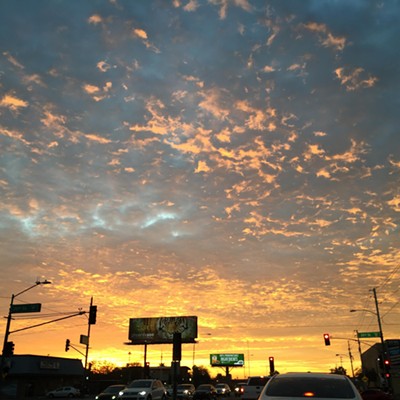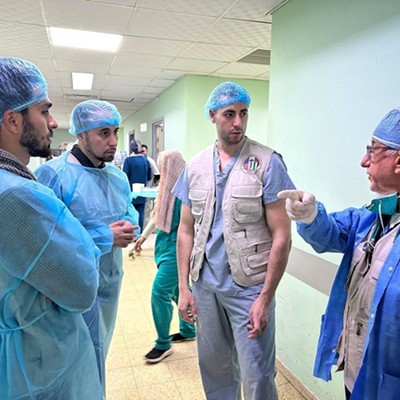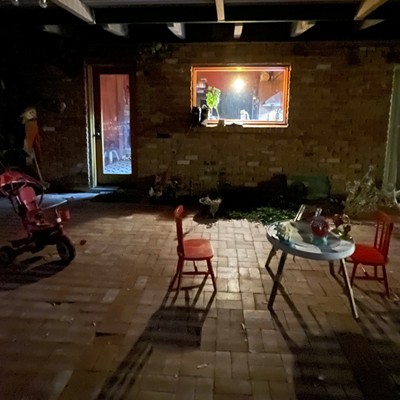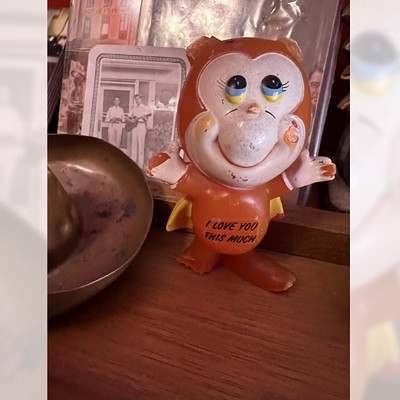The General stands outside the trailer. He coughs and points. "That's Killer, he's been the best partner I've ever had." Killer nudges my hand with his nose, just a sweet old thing burdened by a harmless bark and an overfed frame.
"I was layin' here dyin' one day about three years ago," The General continues, "and I hear this moanin'. So I go outside and there he is. I came in and cooked us up a pork steak and he never left. And I don't even know what type of damn dog he is.”
The General is thin with an old prospector's face, gray horseshoe mustache and watery blues. He carries himself with strange dignity, part roadside crank and electable politician—his smoky, cigarette-husk of a voice sustains the air of an old-man sage. He's unignorable. For one, he's a walking textbook on the Santa Catalina Mountains, particularly anything related to gold and silver, and mining. The 69-year-old's one lasting life relationship is to gold and precious ore. He talks, rants and raves it, like one might after his wife of 40 years had run out on him.
He's flat broke. Been that way years, and lives in a trailer that belongs to a friend. (Earlier today he bummed a Jackson off one-armed Lefty, an old pal he picks up mornings for coffee and sunrise watching.) The General's held hundreds of mining claims in the Catalinas; gold, silver and so on. Just as he knows paths to countless claims up the nearby mountain, he knows routes to bottom. He quit booze nearly a decade ago, for example. Doctor's orders.
The General, as he’s called, is William T "Flint" Carter, a "seasoned prospector." He's also a jewelry maker, artist and author, among other things.
Killer follows The General into the doublewide. The living room is sizable and tidy and smells of cigarettes, spliff and pine needles. There's a single made bed in front of the TV tuned to the History Channel, volume down. The TV is always tuned to the History Channel.
His own art and jewelry is arranged neatly on walls and counter space. It's made from serpentine and marble and other materials he mined himself on Mount Lemmon — including his "Codystone," a medicine ball-sized chunk of gold and silver in quartz, named in tribute to his hero "Buffalo Bill" Cody. He points to it. "See that? It's worth a quarter of a million dollars."
Why doesn’t he sell it?
"Because nobody believes me. Because no one is into mining anymore."
Like his hero Buffalo Bill, The General has long straddled a line between reality and legend, lived a life of mythic proportions. He talks tons but rarely bores, often cramming two, three and five ideas into sparkly run-ons. One five-minute conversation contained the following: He once saw Lana Turner mow her lawn at a Tucson house she owned at Limberlost and First. ("No one knew she lived here, and no one in the neighborhood knew who the hell she was.") Over the years he was swindled of millions in gold and minerals and produces various difficult-to-decipher documentations and financial statements to back such claims. ("I once sent two men to jail for fraud.”) Buffalo Bill in the late 1800s owned a hotel near Oracle, Ariz., it’s history and ownership was hijacked. The hotel is still there. The Lost City in the nearby Cañada Del Oro valley even contained a whorehouse.
His just-released The Canyon of Gold, Buffalo Bill Cody & The Legendary Iron Door Ming Treasure is a sprightly little tome. In it, as the "old prospector with a story to tell," he documents his own decades-long gold fever story and mythologies. Calls it historical fiction. (The General also contributed to the recent Treasure of the Santa Catalina Mountains by Tucson author Robert E. Zucker. And he was featured in Beyond the Legend, a 2010 doc on Buffalo Bill.)
Then there's The Iron Door Mine, supposedly in Cañada del Oro valley below Mount Lemmon. A decades-old news article from the Tucson Citizen says The General "hints that he has found the Iron Door Mine." The piece quotes experts calling the mine “folklore,” a fiction created in the 1923 novel The Mine With the Iron Door by Harold Bell Wright. (The book became a Sol Lesser-produced silent film shot around Oracle. The film still exists). The General says he knows something they don't. One theory involves Jesuit priests who lived in the area in the 1700s, hid their gold in the mine behind an iron door, and returned to Spain. They never came back. He says the treasure connects to the 100 tons of gold buried at New Mexico’s Victorio Peak.
Does it matter if his mineral tales are true or false? His vague documentation proves they’re true. Other documents, some by geologists, one in an eight-page spread in a 2015 issue of Outside Magazine, seriously questioned his claims after testing his mine samples. (The General says the geologist, Jason Price, was wrong). The General has lived as a legend in his mind so long that maybe the world has bent to fit his narrative.
His obsession with gold and Southern Arizona began in the early '70s when he purchased an acre of land on the man-made lake Golder Dam (now gone, breeched in '80). He turned a property chicken coop into a solar-powered house, and his plan was to grow food and survive off grid.
Before that he’d married and had a son. Got drafted (Vietnam) and served in Panama as a military policeman. He returned, divorced and wound up living in Frank Zappa's old apartment in L.A. This was post-Charlie Manson, peace and love was done, but not all the way, and The General talks free love. "I'd go up to San Francisco and Lake Tahoe and we'd pick up every hitchhiker. ..." The General cuts himself off and smiles. The 500 hits of acid he dropped in ’69.
He converted a mail truck into a love machine, its interior outfitted with pink and purple shag carpeting. It featured a swinging bamboo chair that allowed passengers to "swing out the door as we were going down the highway.”
That machine crashed into the greater Tucson area, en route to the Mardi Gras. "We let this little motherfucker drive … and he flipped it over," The General says. "We was asleep in the back of it. We slid 385 feet on its side ... I expected at any second to hear a falling off the cliff, but we stayed on the highway. We had all this dope, and the cops were there. And when that guy wrecked the truck, he said 'Hey, my family's rich!' ... Yeah, they sent us fifty-fucking-dollars."
So The General stayed in town and fell in with an aging Hollywood starlet living here. Hung with Taj Mahal at The Too High Club on Stone Avenue. Says he met Rose Kennedy then too, and lots of bikers. "That's one thing, I knew all these guys but I didn't get into it for the money. I didn't want to end up in jail. Being a cop that's one place you don't want to go."
His bud was Joseph Melville See Jr., "the Princeton hippie," a geologist. There's a picture of the two of them together at his cabin near Mount Lemmon. See Jr. was Linda's first husband before she married Paul. "I said 'Was you really JoJo from the Beatles' song ‘Get Back’? He says, 'I don't want to talk about that shit.'" Paul raised See’s daughter, Heather, "and that broke his heart. He died a year after Linda did." (See Jr.’s death was ruled suicide but many suspected murder).
The General’s afraid he’s running out of time, faster than the rest of us, and bucks autumn-year ennui by holding on to any kind of future that's worth living. Not easy because he doubles over in pain often, smokes weed for the pain. Says it’s PCB poisoning, which he “contracted from General Electric. My dad used to haul waste from the factory and all the kids would play in it.” He swears he has five testicles, like his dad, from the PCB. Mom, dad and half-brother all died from cancer. (PCBs are found in old fluorescent lighting and electrical appliances among other things. PCB manufacturing stopped in '77).
Whether he realizes or not, he’s leaving a legacy in donations. Antiquated pieces, such as bolo ties and pendants, have gone to museums and historical societies, like Nebraska's Fort Cody Trading Post, the Oklahoma Historical Society and Tucson's Saguaro Rotary Club. He saves letters of thanks from all of them. He has a little mineral workshop next to the trailer too, and off the driveway there's an outdoor shed filled with books and artifacts from the Oracle area, the Catalinas and old mines, circa 1800s — chunks of metals, pottery, an old confederate bullet belt, pieces of a stage coach, and all manner of rusted things. His vast collection of ore and remnants of mining gear from bygone eras are on display at the Oracle Inn in Oracle, Arizona. He annually hosts Buffalo Bill Cody Oracle Days, a celebration of Buffalo Bill's birthday. He's keen to open a museum, an educational center for future generations, where his gold and minerals and artifacts can be displayed. He needs $200,000 to make it happen.
The General talks about being a man out of time, and his little lonely world, where he's dying. His voice trails off ... and he picks up again, talking of painter Ted DeGrazia, who died in early '82. DeGrazia was a friend who lectured him on gold fever. "DeGrazia said to me, 'Boy, you're reaching for that brass ring on the merry-go-round and you're going to find out it's in the nose of a bull. ...'"
Buffalo Bill Cody Days happens 1 to 5 p.m., Saturday and Sunday, Feb. 25-26 at Oracle Inn Steakhouse & Saloon, 305 E. American Ave., Oracle. 896-3333; emol.org/flintcarter/codydays.
[
{
"name": "Air - MedRect Combo - Inline Content 1",
"component": "29441156",
"insertPoint": "1/3",
"requiredCountToDisplay": "9",
"parentWrapperClass": "fdn-ads-inline-content-block"
},{
"name": "Top Stories Video Pair",
"component": "27651162",
"insertPoint": "10",
"requiredCountToDisplay": "1",
"parentWrapperClass": "fdn-ads-inline-content-block"
},{
"name": "Air - MedRect Combo - Inline Content 2",
"component": "29441158",
"insertPoint": "2/3",
"requiredCountToDisplay": "10",
"parentWrapperClass": "fdn-ads-inline-content-block"
},{
"name": "Air - MedRect Combo - Inline Content 3",
"component": "29441159",
"insertPoint": "1000",
"requiredCountToDisplay": "15",
"parentWrapperClass": "fdn-ads-inline-content-block"
}
]







